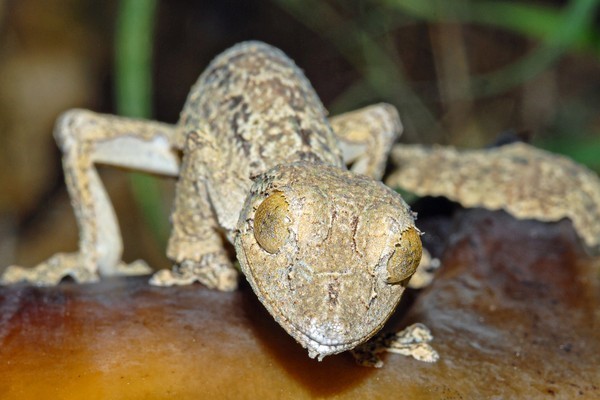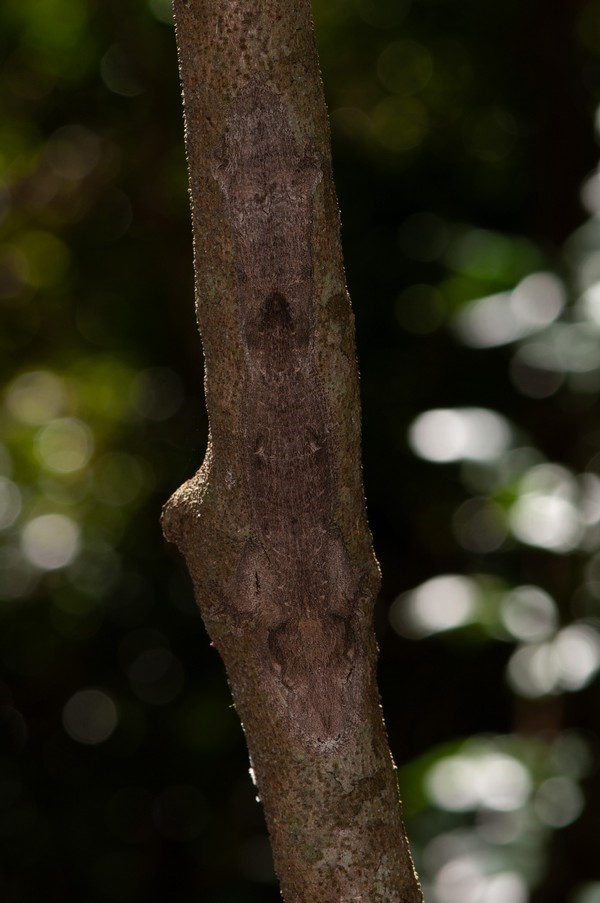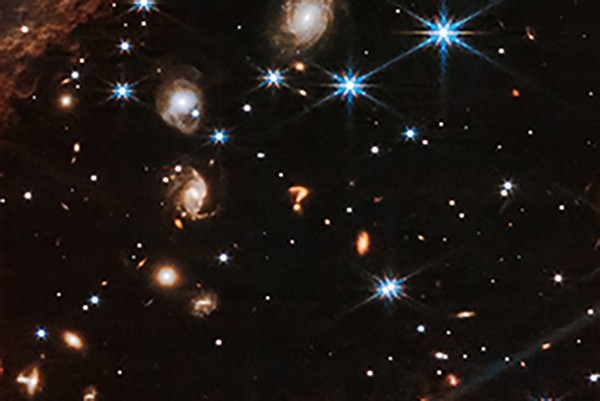This gecko's camouflage is so good it masqueraded as
another species.
As night falls on the northern forests of Madagascar, trees
come alive. What appears to be a piece of bark peels off a tree trunk and
starts slowly crawling along a branch. It's actually Uroplatus garamaso, a newly
identified species of leaf-tailed gecko.
اضافة اعلان
This animal is a dazzling camouflager, better than the
chameleon but long hidden in plain sight. Many of the features that make it
unique are still an evolutionary mystery.
"They look totally different from all of the other
reptiles," said Mark D. Scherz, curator of herpetology at the Natural
History Museum of Denmark and a co-author of the paper describing the find. The
22 species of leaf-tailed geckoes unique to Madagascar can be split into two
categories: those who've evolved to look uncannily like leaves and those who
imitate tree bark. U. garamaso and the others that blend into bark have a
fringe hugging their flanks and legs, a beard around the bottom of their chin,
and flattened tails.
During the day, they fold out that fringe and rest on tree
trunks, becoming "practically invisible," Scherz said. At night, they
come out of that sleeping position and prowl the forest for invertebrate prey,
like "little leopards or jaguars," he added.
 The James Webb Space Telescope captured a
near-infrared image of actively forming stars known as Herbig-Haro 46/47. This
image exhibits a peculiar question mark shape. (NASA, ESA, CSA, Joseph
DePasquale (STScI), Anton M. Koekemoer (STScI) via The New York Times)
The James Webb Space Telescope captured a
near-infrared image of actively forming stars known as Herbig-Haro 46/47. This
image exhibits a peculiar question mark shape. (NASA, ESA, CSA, Joseph
DePasquale (STScI), Anton M. Koekemoer (STScI) via The New York Times)
U. garamaso is so talented at disguise that it's long been
mistaken for another leaf-tailed gecko in Madagascar called U. henkeli. It was
probably British pet traders in the early 2000s who first wondered if they had
their hands on a different beast, Scherz said. The traders noticed small
physical differences. This lizard is smaller than U. henkeli and has a narrower
tail. Its diamond-pupiled eyes are tinted a gaudier yellowish-red. — SOFIA
QUAGLIA
The Biggest Question Mark in Astronomy? You're Looking at
It.
The astronomers will tell you it is just an optical
illusion, a pair of galaxies caught in the act of mating as seen from the wrong
angle. Happens all the time.
In the 1960s and '70s, Halton Arp, an astronomer in Southern
California, asserted that galaxies millions of light-years apart — but which
appeared superimposed together in the sky — were interacting locally. His claim
cast doubt on the Big Bang theory of the universe. Astronomers now agree that
he was wrong.
Now a genuine question mark has been discovered, in the
corner of a Webb telescope observation of a pair of dust clouds known as
Herbig-Haro 46/47 that are in the process of forming into two stars. The
discovery made a splash on social media. "Ze space mall information kiosk
has been found by JWST," a commenter joked on X, the site formerly known
as Twitter.
If you accept the spooky rules of quantum mechanics and the
premise, as Albert Einstein disapprovingly put it, that God plays dice with the
universe, then you have to accept that chance and randomness are a fundamental
bedrock of reality. In such a universe, where the laws of physics have been
grinding away for 14 billion years, coincidences are unforeseeable but
inevitable.
 during the day, Uroplatus garamaso rest hidden,
head-down on tree trunks, with their hindlimbs outstretched and fringes pressed
against the bark, making them almost impossible to spot. (Mark D. Scherz/Natural History Museum of
Denmark via The New York Times)
during the day, Uroplatus garamaso rest hidden,
head-down on tree trunks, with their hindlimbs outstretched and fringes pressed
against the bark, making them almost impossible to spot. (Mark D. Scherz/Natural History Museum of
Denmark via The New York Times)
Still, there are times when it's worth stepping back to
listen to "the music," as Einstein once referred to the beauty and
mystery of the cosmos. You are free to consider that question mark as alien
graffiti, a comment on both their and our relation to existence. Point being,
we've barely begun to know anything — that's why we build telescopes. — DENNIS
OVERBYE
Hogfish 'See' With Their Skin, Even When They're Dead
As a marine biologist, Lorian Schweikert knew hogfish could
change color to match their surroundings. But as an angler, she noticed
something that wasn't in the textbooks: Hogfish can camouflage even after
they're dead.
When Schweikert saw a hogfish with a conspicuous
spearfishing hole through its body change color to match the texture of a boat's
deck, "it gave me this idea that the skin itself was 'seeing' the
surrounding environment," she said. Research by Schweikert and her team
provides an explanation for how hogfish blend into their background, even in
the afterlife. In a study published in Nature Communications, they identified a
new type of cell deep in the hogfish's skin that might allow the fish not only
to monitor its surroundings but also to edit its skin color.
Schweikert suspected that the hogfish's ability to
camouflage while dead was just a quirk, that some part of the color-changing
system was taking a while to get the memo that it was a former fish. Schweikert
hoped the answer might lie in the arrangement of the cells in the hogfish's
skin. Her team used glowing antibodies to pinpoint the opsins, and transmission
electron microscopy allowed them to peer into the cellular structures.
The imaging revealed that the opsins weren't on the surface
of the skin, where they would have the best view of the outside world. Instead,
they were beneath a layer of chromatophores — "inkjet" cells that
produce a color change by expanding and contracting packets of pigment — and
concentrated in a previously unknown cell type. — ELIZABETH ANNE BROWN
Neptune’s Clouds Have Vanished, and Scientists Think They
Know Why
Each planet of the solar system has its own look. Earth has
aquamarine oceans. Jupiter has panchromatic tempests. Saturn has glimmering
rings. And Neptune has ghostly clouds — or it used to. For the first time in
three decades, the electric-blue orb is almost completely cloud-free, and
astronomers are spooked.
Neptune’s cloud cover has been known to ebb and flow. But
since October 2019, only one patch of wispy white has been present, drifting
around the planet’s south pole.

An image of Herbig-Haro 46/47 with a question
mark appearing at the center-bottom of the frame, to the right of the reddish
cloudy material. (NASA, ESA, CSA, Joseph DePasquale (STScI), Anton M. Koekemoer
(STScI) via The New York Times)
To crack the case of the vanishing clouds, scientists
spooled through 30 years of near-infrared images of Neptune made with ground-based
observatories and the Hubble Space Telescope. In a new study, Imke de Pater, an
astronomer at the University of California, Berkeley, and her colleagues named
the prime suspect in this cloud cleansing: the sun.
The sun goes through cycles of hyperactivity and tranquility
driven by the repeated inversion of the sun’s magnetic field. These cycles rise
and fall in sync with Neptune’s cloud cover. During the sun’s nadir, Neptune’s
vaporous veil fades away — although it’s unclear why the current dearth of clouds
is so extreme compared with previous cycles.
It has been suggested these two celestial objects may be
improbably linked in this manner. But this study offers evidence that Neptune’s
cloudy couture can be attributed to solar flare, hinting at the ice giant’s
mysterious dynamism. “That UV emission from the sun could dictate Neptune’s
cloud structure is akin to an orchestra conductor giving directions to a lone
violin player 2.8 billion miles away,” said astrophysicist Grant Tremblay, who
was not involved with the work. — ROBIN GEORGE ANDREWS
Read more Odd and Bizarre
Jordan News





